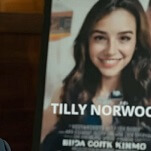Wakanda is experiencing a well deserved resurgence in interest. Between excitement for the Black Panther movie and the good press around Ta-Nehisi Coates and Brian Stelfreeze’s comic, it’s a smart move for Marvel to expand the franchise. It’s even smarter to recruit Roxane Gay to helm a new title in keeping with Coates’ work.
Black Panther: World Of Wakanda #1 (Marvel) is a prequel to the current Black Panther title, giving the backstory of all the women around him. Given how much of Black Panther #1 was augmented by exposition and explanation of what had been happening before the reader showed up, it’s helpful to go back and figure out how all this has happened. Gay and artist Alitha E. Martinez build specifically on the world of the Dora Milaje, the all-female group of personal body guards that the Wakandan royal family relies on. Gay is entirely new to comics, but Martinez has been drawing covers and contributing to a couple of books here and there, and they dive in with confidence with a strong story. It doesn’t hurt that they’re telling the start of the love story that has captured so much attention in Black Panther. It reads a little bit like fan-fiction in the best possible way, a meet-cute that’s not so cute and resistance to the inevitable that adds layers and nuance to characters who were already interesting to begin with. Colorist Rachelle Rosenberg and letterer Joe Sabino solidify Martinez’s already strong art, and the transition from Stelfreeze’s recap and credit pages to the story itself is smooth.
While Aneka and Ayo are the stars of the Dora Milaje, on the other side of World Of Wakanda’s character spectrum is Zenzi, framed in Black Panther as enemy of T’Challa and his people. Poet Yona Harvey worked with Coates to script the other part of World Of Wakanda, giving Zenzi her own backstory and depth. Harvey is also a newcomer, but illustrator Afua Richardson is the artistic talent behind Genius, a book that imagines what would happen if the greatest military mind in a generation was born in South Central Los Angeles, and Genius fits neatly with World Of Wakanda. Richardson’s style is sharper and sketchier than Martinez’s, but the two sections share a letterer and colorist Tamra Bonvillain does an excellent job making the worlds feel distinct but connected through the palette. The team gives Zenzi serious emotional heft, showing her strength and beliefs for what they are, distinct and rich with motivation rather than just in opposition to T’Challa.
Black Panther was already a revelation, and it was a pleasant surprise to see Afrofuturism from one of the biggest comics publishers in the world. It’s still broad and theatrical, still massive in scope and import. World Of Wakanda feels more intimate, and all the more powerful for it. It’s deeply invested in the identities of black women both as characters and more importantly as creators, making it clear that these aren’t just background characters in T’Challa’s life. Reading one is not required to enjoy the other, but paired together they make an important and much needed statement about love, duty, and how perspective can get in the way of making the best decisions. [Caitlin Rosberg]
Matt Kindt and David Rubín are two accomplished cartoonists who have shown remarkable imagination, style, and intelligence in their solo work, but maybe they should think about a long-term partnership given the strength of their new collaboration,
Ether. Written by Kindt with art and lettering by Rubín,
Ether #1 (Dark Horse Comics) follows a scientist, Boone Dias, who thinks that every supernatural phenomena can be explained with facts, including the eponymous magical dimension that he travels to through a glowing portal in a Venetian garden. Boone’s obsession with figuring out how everything works allows Kindt to indulge in the detail-oriented world-building that has become a defining aspect of his work, but it also adds humor to the story as Boone’s skepticism fights against the aggressive fantasy of the world around him. (It’s similar to Brian Azzarello and Cliff Chiang’s
Doctor 13: Architecture And Mortality in this regard.)
Boone’s application of the scientific method has made him a valuable addition to The Ether as a detective, and he takes on his most dangerous case yet when a magic bullet kills The Blaze, the protector of the realm. Kindt is very fond of the murder mystery as a narrative framework, but he consistently finds new angles to approach this general concept by placing them in different settings that change how the stories unfold. The cyberpunk superhero future of Rai brings spectacular action to the mystery, whereas the underwater research base of Dept. H takes the mystery into claustrophobic thriller territory. Ether shares certain things in common with these other books—it has a sprawling fantasy world like Rai, and Dept. H’s sense of claustrophobia when Boone is pulled out of that fantasy world and into his home dimension—but the presence of Rubín makes it a very different beast.
The cartoonish elements of Rubín’s artwork bring a whimsical lightness to the story, and emphasizing fun and humor at the start of the first issue makes for an engaging entry into this world. The mood shifts when Boone is taken to the crime scene, and Rubín’s layouts and composition amplify the impact of that moment: The six panels of Boone, his ape accomplice Glum, and Ether’s mayor walking up the stairs to The Blaze’s bedroom are presented from a fixed side angle that sets a monotonous pace for the monotonous climb, and that pace is broken with a wide panel that also slightly shifts the angle when the mayor opens the door.
Walking into the room results in a dramatic switch to a bird’s eye view of the circular space, and The Blaze’s dead body is sprawled in the middle of it, a target in the middle of the bullseye. The weapons all along the walls emphasize the violence of this picture, and the rugs underneath The Blaze are arranged in a starburst effect that can be viewed as floral or explosive (maybe it’s supposed to be both). This is a big moment in the narrative and there’s a lot of thought put into the visuals to make sure the reader feels that gravity.
That specificity can be found throughout Ether, and Rubín is constantly exploring new ways to invigorate the script with his art and lettering. Boone’s investigation of The Blaze’s crime scene is energized with hand-drawn sound effects and cleverly layered planes of magnification. A casual conversation between Boone and Glum becomes dynamic when Rubín puts their talking heads along the side of the page and leaves the middle space available to show their slug taxi zooming through town. Ether is a gorgeous book, and that beauty is even more impressive because it’s in service of sophisticated storytelling. [Oliver Sava]
This Thanos guy, he’s pretty popular. Popular enough that at some point Marvel decided it was necessary to wedge him into every event storyline. He had a good few moments during the build-up to
Secret Wars but mostly floundered there due to being superfluous to the main action. The events of
Secret Wars set him up for an appearance in the still-current
Civil War II. But if Jonathan Hickman struggled mightily to make the character fit into his story, Brian Michael Bendis threw up his arms entirely, plugging Thanos into the first act of the
Civil War sequel in a part that could have been played by any one of two dozen sufficiently dangerous Marvel baddies.
He’s got a high profile now due to his cameo appearances in a few Marvel movies. His books sell well in collected edition, too. Parallel to his usage in the mainstream Marvel crossovers, his creator Jim Starlin produced his own swan song to the character in the form of a recent series of graphic novels that culminated with this year’s Infinity Finale. (Worth noting: The Starlin graphic novels did eventually end up tying back in with Secret Wars, with Starlin tying up one of that series’ biggest unresolved plot.) Now he’s back in a new ongoing from new Marvel mainstay Jeff Lemire and longstanding Marvel mainstay Mike Deodato.
After a busy few years and a mixed track record, how does Thanos fare on his own? Neither well nor poorly. The new Thanos #1 (Marvel) does an adequate job of bringing both new and old readers up to speed, but little more. Up until recently, the character’s history was relatively streamlined, with few creators veering too far from Starlin’s established template (and those that did suffered the indignity of seeing their “false” Thanoses turned into clones). That horse left the barn a while back, and the barn went up in a firestorm soon after: Now the character is saddled with superfluous backstory in the form of a son, Thane. Although Thane is a remarkably uninteresting character, he provides the impetus for what will apparently be the series’ major conflict. Thanos will be hunted by a group of cosmic heavy-hitters that includes his own brother Starfox as well as the Champion, of the Elders Of The Universe.
As with Tomb Of Dracula in the 1970s, the formula for villain books remains remarkably consistent: assemble a group of heroes to go after the bad guy and subsequently follow two parallel plot tracks. The problem is that the other track—that of Thanos himself—offers us a version of Thanos that retains precious little of Starlin’s wit or melancholy. This is Thanos as he exists in 2016: a cosmic thug with a lust for power but little more. Deodato’s art picks up where he left off from Bendis’ Iron Man, becoming more bold and design-oriented while taking full advantage of Frank Martin’s rich color palette. The art and color are the best parts of the book, which is perfectly serviceable in every way except for the fact that its protagonist is little more than the ominous cipher who appears in the post-credits scenes of Marvel movies. [Tim O’Neil]
Thin lines scribbled on a great white expanse, Sam Alden’s
Sledgehammer (
Hazlitt) moves, squirms, and squiggles. Like many of Alden’s other stories,
Sledgehammer centers on the relationship with two people, with an oblique drama emerging out of their inability to emotionally engage one another. Only a quarter serialized, the first installment revels revels in what Alden does best. Granular and quotidian, the comic unfolds as a languid sequence of snapshots—not scenes per se, but snippets and moments.
Recalling real life, Sledgehammer’s storytelling is incomplete and full of uncertainty, a discourse mediated by white noise. A clang, clang, clang rings out—represented by Alden as an intrusive opacity of redness that approximates the shape of a speech balloon. Protagonist Darya’s mother, seemingly reeling from a divorce, is renovating her former husband’s study. “If there’s stuff in there you want,” she tells Darya. “Grab it. I’m gonna literally burn everything.” Their relationship takes center stage here, but their interactions may come off as ironically detached, like something plucked from a Wes Anderson movie. A gulf has formed between them, and they are trying, and failing, to cross it.
Alden draws this alienation by physically distancing his figures. He sets them against white backgrounds—seemingly infinite canvases that distort spatial relations—and he largely keeps them apart. Alden rarely draws them in the same panel, instead cutting back and forth between them as they speak. When he does draw them together, they are quiet and still, separated by space and unable to make eye contact. The only time they touch—the only time they are able—they have found a mediator for their relationship: a short cartoon that Darya has finished animating. It is here that they find a proxy through which they can safely communicate.
It is unclear how Alden will continue to tease out this emotional entanglement, but it is clear that he will do it strikingly. Aside from the enticing emotional storytelling, Sledgehammer is beautifully composed. Alden’s lines move dynamically across the page, breaking, curling, and collapsing under their own minuscule weight, and his panels are riven through with a palpable anxiety. The sunset’s particular hue of pink, scribbled just so, ensconced in white and set behind a deep blue tree—Alden captures a fleeting perfection there, a pastoral ideal that surpasses reality. And yet, it surpasses reality in an effort to capture reality. The visual circumlocution that Alden centers in his aesthetic—not just here, but in all his panels—is not an attempt to modify or augment reality; rather, it is a poetic attempt to share a particular feeling evoked by that reality. That is the goal of art, to help us see as another sees, to feel as another feels, and it is a goal whose value is self-evident. As brief as Sledgehammer’s first chapter is, it’s a moving and compelling read, an estimation that only grows the more it is left to percolate. [Shea Hennum]







































